
The Braamfontein Explosion was an explosion of a freight train carrying dynamite in Braamfontein, a suburb of Johannesburg, in 1896. It was one of the largest non-nuclear explosions in history.

The Braamfontein Explosion was an explosion of a freight train carrying dynamite in Braamfontein, a suburb of Johannesburg, in 1896. It was one of the largest non-nuclear explosions in history.
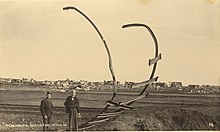
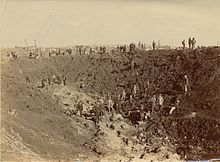
On 16 February 1896, a freight train with eight trucks of dynamite – 2300 cases of 60lb each, or about 60 tonnes – was put in a siding at Braamfontein railway station. The dynamite was destined for nearby mines, but the mine's stores of dynamite were already full so the train was left in the siding – for days, in very hot weather – until there was somewhere to store the dynamite. [1]
On the afternoon of 19 February, after labourers had started to unload the train, a shunter came to move it to another part of the siding; but after the impact of the shunter, the dynamite exploded. The explosion left a crater 60 metres long, 50 metres wide and 8 metres deep. The explosion was heard up to 200 kilometres away. Herman Eugene Schoch recorded hearing the explosion in Rustenburg, approximately 120 kilometres (75 mi) away. [2]
Suburbs as far away as Fordsburg were seriously damaged, and about 3,000 people lost their homes. [3]
Accounts vary, but it is thought that over 70 people were killed [4] and more than 200 were injured. A memorial at the Braamfontein cemetery reads that 75 "whites and coloured" were killed. [5]
In 2012, artist Eduardo Cachuco created "Explosion, 1896", a complex artwork based on the explosion which was shown at the "looking glass" exhibition.

The University of the Witwatersrand, Johannesburg, commonly known as Wits University or Wits, is a multi-campus public research university situated in the northern areas of central Johannesburg, South Africa. The university has its roots in the mining industry, as do Johannesburg and the Witwatersrand in general. Founded in 1896 as the South African School of Mines in Kimberley, it is the third oldest South African university in continuous operation.

Johannesburg is a large city in Gauteng Province of South Africa. It was established as a small village controlled by a Health Committee in 1886 with the discovery of an outcrop of a gold reef on the farm Langlaagte. The population of the city grew rapidly, becoming a municipality in 1898. In 1928 it became a city making Johannesburg the largest city in South Africa. In 2002 it joined ten other municipalities to form the City of Johannesburg Metropolitan Municipality. Today, it is a centre for learning and entertainment for all of South Africa. It is also the capital city of Gauteng.
The following lists events that happened during 1988 in South Africa.
The following lists events that happened during 1896 in South Africa.
The M1 De Villiers Graaff motorway is a metropolitan route and major freeway in the City of Johannesburg, South Africa. The highway connects the southern areas with the city centre and extends further north through Sandton into the Ben Schoeman Highway towards Pretoria. Construction began in 1962 and resulted in the demolition of many properties and houses including numerous historical Parktown Mansions.
Parktown is a wealthy suburb of Johannesburg, South Africa, and is the first suburb north of the inner city. It is affectionately known as one of the Parks, others including Parkview, Parkwood, Westcliff, Parktown North, Parkhurst and Forest Town. Parktown is one of Johannesburg's largest suburbs, neighbouring Hillbrow, Braamfontein and Milpark to the South; Berea and Houghton to the East; Killarney and Forest Town to the North, and Westcliff, Melville and Richmond to the West. Originally established by the Randlords in the 1890s, Parktown is now home to many businesses, hospitals, schools, churches and restaurants, whilst still maintaining quiet residential areas. It is also home to three of the five campuses of the University of the Witwatersrand including the education campus, medical school and Wits Business School. It is located in Region F of the City of Johannesburg Metropolitan Municipality.
Braamfontein is a central suburb of Johannesburg, in South Africa, seat of the Constitutional Court of South Africa and some of South Africa's major corporations such as Liberty Holdings Limited, JD Group, Sappi, and Bidvest Bank and Hollard. Situated due north of the city centre, Braamfontein is the fourth-largest office node in the city of Johannesburg containing many multi-storied buildings representing various architectural styles including Art Deco and Brutalist. Numerous office buildings have and are in the process of being converted to residential apartments. The offices of the Johannesburg City Council and the University of the Witwatersrand are situated in Braamfontein. The Nelson Mandela Bridge is a landmark that connects Braamfontein to the city centre, traversing South Africa's most extensive passenger train marshalling yard. Jan Smuts Avenue and Empire Road are two major road thoroughfares that run through the suburb.
There have been many extremely large explosions, accidental and intentional, caused by modern high explosives, boiling liquid expanding vapour explosions (BLEVEs), older explosives such as gunpowder, volatile petroleum-based fuels such as gasoline, and other chemical reactions. This list contains the largest known examples, sorted by date. An unambiguous ranking in order of severity is not possible; a 1994 study by historian Jay White of 130 large explosions suggested that they need to be ranked by an overall effect of power, quantity, radius, loss of life and property destruction, but concluded that such rankings are difficult to assess.

Rail transport in South Africa is an important element of the country's transport infrastructure. All major cities are connected by rail, and South Africa's railway system is the most highly developed in Africa. The South African rail industry is publicly owned.

The Frank Slide was a massive rockslide that buried part of the mining town of Frank in the District of Alberta of the North-West Territories, Canada, at 4:10 a.m. on April 29, 1903. Around 44 million cubic metres/110 million tonnes of limestone rock slid down Turtle Mountain. Witnesses reported that within 100 seconds the rock reached up the opposing hills, obliterating the eastern edge of Frank, the Canadian Pacific Railway (CPR) line and the coal mine. It was one of the largest landslides in Canadian history and remains the deadliest, as between 70 and 90 of the town's residents died, most of whom remain buried in the rubble. Multiple factors led to the slide: Turtle Mountain's formation left it in a constant state of instability. Coal mining operations may have weakened the mountain's internal structure, as did a wet winter and cold snap on the night of the disaster.
The Hjuksebø train disaster occurred on the Sørlandet Line between Hjuksebø and Holtsås, Telemark, Norway on 15 November 1950. The Kristiansand-to-Oslo express had been due to pass through Hjuksebø, but was delayed, and the shunter believed he had time to turn a waiting freight-train around before it arrived, by shunting a number of freight cars out of the way. As he had failed to attach them to the engine, however, the cars ran downhill towards Holtsås station, straight into the express, killing fourteen. At the time, it was Norway's worst peacetime railway accident.

Johannesburg Park Station is the central railway station in the city of Johannesburg, South Africa, and the largest railway station in Africa. It is located between the Central Business District and Braamfontein, in the block bordered by Rissik, Wolmarans, Wanderers, and Noord Streets. Park Station lies on the main Witwatersrand railway line that runs East-West from Krugersdorp to Germiston. The first four stations to the east are Doornfontein, Ellis Park, Jeppe and George Goch Stations.
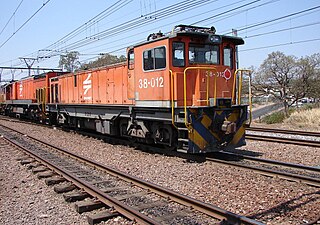
The Spoornet Class 38-000 of 1992 is a South African electro-diesel locomotive.

The South African Railways Class 21 2-10-4 of 1937 was a class of steam locomotives used in South Africa.

Bickershaw Colliery was a coal mine, located on Plank Lane in Leigh, then within the historic county boundaries of Lancashire, England.
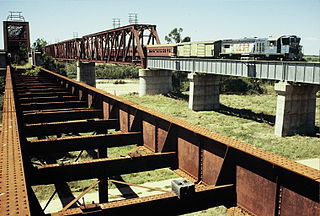
The Great Northern Railway is a 1067 mm gauge railway line in Queensland, Australia. The line stretches nearly 1,000 kilometres linking the port city of Townsville, Australia to the mining town of Mount Isa in north-west Queensland. Along with a passenger service called the Inlander, it is a major freight route connecting the Mount Isa Mines to the Port of Townsville. In 2010, the line moved 5.8 million tonnes of cargo, and this is expected to increase significantly in coming years.
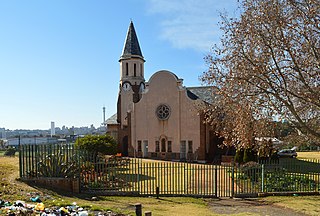
Vrededorp is a suburb of Johannesburg, South Africa. It is located in Region F of the City of Johannesburg Metropolitan Municipality. Vrededorp is situated on the North-Western side of Johannesburg and is 1,764 m (5,788 ft) above sea level.

The NZASM 40 Tonner 0-6-2T of 1892 was a South African steam locomotive from the pre-Union era in Transvaal.
The Fordsburg Reformed Church was a congregation of the Dutch Reformed Church in South Africa (NGK) that served the western Johannesburg suburb of Fordsburg from November 6, 1896, to 1988.